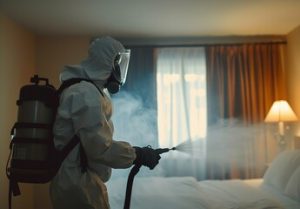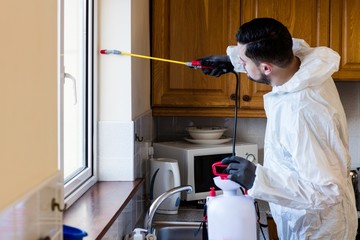Pests invade when least expected. They disrupt comfort, damage property, and pose health risks. Modern Ben’s Pest Control goes beyond spraying chemicals. It blends science, strategy, and prevention to restore balance.

Understanding pest behavior is essential. Each species has unique patterns, habitats, and vulnerabilities. Professionals study these to design targeted interventions. This approach reduces unnecessary treatments and enhances efficiency.
Digital monitoring has transformed pest management. Sensors and cameras detect infestations early. Data analysis predicts hotspots before damage spreads. Technology allows proactive measures instead of reactive fixes.
Integrated pest management focuses on long-term solutions. It combines chemical, biological, and environmental strategies. This reduces reliance on harsh pesticides. Home safety and sustainability remain top priorities.
Inspection is the first step in control. Experts evaluate structure, landscape, and sanitation practices. Every crack, corner, and hiding spot is checked. Early identification ensures precise treatment.
Customized solutions make modern pest control effective. Not all pests respond to the same methods. Plans are tailored to the infestation type, location, and severity. This personalized approach maximizes results.
Eco-friendly options are now widely available. Biodegradable sprays and traps reduce environmental impact. Natural predators can be introduced to control populations. Sustainability and safety are no longer optional in pest management.
Regular maintenance prevents reinfestation. Scheduling inspections and treatments keeps homes protected. Routine checks catch new threats early. Prevention is often more effective than cure.
Commercial spaces also benefit from advanced pest solutions. Businesses face risks from rodents, insects, and birds. Professional programs maintain hygiene standards. Consistent monitoring protects both customers and employees.
Education plays a critical role in prevention. Residents learn about sanitation, waste management, and structural care. Awareness reduces conditions that attract pests. Informed habits complement professional interventions.
Technology-assisted treatment improves efficiency. Automated sprayers and bait stations deliver precise dosages. This reduces chemical exposure and human error. It also allows monitoring without constant presence.
Rodent control has evolved significantly. Traps are smarter, more humane, and data-driven. Professionals track activity to identify nesting patterns. Targeted action reduces population without widespread harm.
Insect control requires careful strategy. Cockroaches, ants, and termites respond differently to treatment. Professionals select methods that eliminate colonies at the source. Persistent infestations are addressed without excessive chemical use.
Seasonal changes affect pest activity. Warm months increase insect activity, while rodents seek indoor shelter in cold periods. Awareness of these patterns helps in timely interventions. Preventive scheduling aligns with natural cycles.
Pest control extends to landscaping. Overgrown vegetation, standing water, and mulch piles can harbor insects. Experts modify surroundings to reduce habitats. Environmental management is a core component of effective solutions.
The human factor cannot be ignored. Clutter, poor sanitation, and untreated leaks encourage infestations. Professionals advise on behavioral changes. Simple adjustments reduce pest access and survival rates.
Monitoring tools now include smartphone integration. Clients can receive alerts and updates on pest activity. Reports and recommendations are delivered digitally. This convenience improves engagement and compliance.
Health considerations are paramount. Some pests carry diseases or trigger allergies. Timely intervention prevents exposure and contamination. Pest control is as much about wellness as it is about property protection.
Bird management is increasingly incorporated. Birds can damage structures and spread pathogens. Netting, deterrents, and habitat modification are used responsibly. Ethical solutions respect wildlife while protecting human spaces.
Termite control has become sophisticated. Baiting systems, soil treatments, and monitoring stations track colonies. Early detection prevents structural damage. Long-term strategies ensure lasting protection.
Waterborne pests are often overlooked. Mosquitoes and flies breed in stagnant water. Proper drainage and targeted treatment eliminate these threats. This reduces nuisance and disease risk simultaneously.
Emergency services handle sudden infestations efficiently. Some pest problems require immediate attention. Rapid response teams identify, contain, and eradicate threats quickly. Minimizing exposure time is crucial for safety.
Education extends to commercial staff. Training ensures daily habits support long-term pest control. Trash management, cleaning routines, and proper storage reduce attractants. Consistency complements professional efforts.
Data collection enhances strategy. GPS mapping of infestations and activity patterns helps optimize interventions. Historical data predicts seasonal risks. Analytics turn pest control into a proactive science.
Traps and baits are now more specialized. Each pest type requires specific lures or formulations. Precision reduces collateral exposure. Safety is maintained for humans and pets.
Chemical treatments are refined. Modern formulations minimize toxicity while remaining effective. Professionals calculate exact dosages to avoid overuse. Controlled application reduces environmental footprint.
Integrated programs reduce recurring issues. Combining inspection, treatment, prevention, and education creates comprehensive protection. Short-term fixes rarely address the root problem. Consistency ensures long-term success.
Urban environments present unique challenges. High-density living, shared walls, and limited outdoor space affect pest behavior. Custom strategies account for these factors. Solutions are tailored to urban living conditions.
Wildlife intrusion requires specialized techniques. Raccoons, squirrels, and bats demand humane exclusion. Professionals seal entry points while maintaining ethical standards. Conflict resolution blends expertise with compassion.
Routine audits track efficacy. Post-treatment evaluations measure success. Adjustments are made for evolving conditions. Continuous improvement is central to professional pest management.
Biological methods are gaining traction. Beneficial insects, nematodes, and microbial treatments reduce chemical reliance. Ecosystem balance is restored naturally. Science-driven solutions are both innovative and safe.
Professional pest control combines artistry with precision. Skilled technicians adapt to site-specific needs. Knowledge, technology, and experience intersect. Results are measurable, safe, and sustainable.
Insurance and documentation support liability management. Commercial clients often require proof of pest control. Accurate records demonstrate compliance with regulations. Transparency builds trust between clients and providers.
Education campaigns target recurring misconceptions. Not all pest problems are visible immediately. Understanding pest life cycles prevents premature conclusions. Awareness enhances cooperation and long-term effectiveness.
The industry is moving toward predictive solutions. AI and machine learning analyze patterns for preventive actions. Future infestations may be mitigated before occurrence. Technology amplifies human expertise in pest control.
Homeowners increasingly adopt a holistic approach. Combining structural repairs, sanitation, landscaping, and professional services addresses root causes. Infestations are prevented rather than repeatedly treated. Long-term investment reduces costs and stress.
Global challenges such as climate change affect pest activity. Warmer temperatures and altered rainfall patterns influence populations. Professionals adapt strategies to meet evolving environmental conditions. Flexibility is key in modern pest management.
Community engagement is also essential. Neighborhood-level coordination prevents cross-property infestations. Awareness campaigns, clean-ups, and shared schedules reduce risk collectively. Collaborative strategies amplify individual efforts.
Pest control is no longer reactive. Preventive measures, technology, and education empower residents. Modern solutions prioritize safety, sustainability, and effectiveness. Every intervention is part of a larger system of balance.
Ultimately, pest control protects more than property. It safeguards health, comfort, and peace of mind. Professional services combine science, ethics, and convenience. Effective pest management transforms homes and workplaces into safe, livable spaces.
This approach signals a new era in pest management. Every treatment is data-informed, eco-conscious, and tailored. Infestations are mitigated efficiently without compromising safety. The integration of technology, strategy, and human expertise ensures lasting results for modern living.
